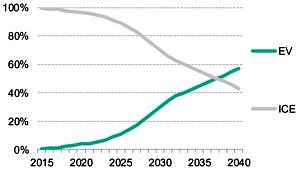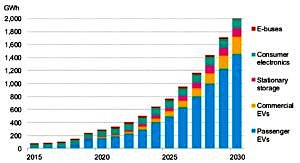The need for wider, sustainable industrial practices harvesting renewable primary-energy sources in an efficient manner to minimize pollutants emissions is a key EU priority. The effort for a more sustainable transportation sector by improving the state-of-the-art of existing cooling technologies with reference to EVs paves the road for next-generation BTMSs able to handle higher charge/discharge rates, leading to increased mileage and overall life cycle, as well as reduced maintenance requirements. Optimized practices with application to the booming EVs industry will be of benefit for other vast technological areas, where high heat-flux dissipation is of importance.
The forecast for the EV penetration in passenger car transportation can be seen on the left graph shown below. The trend in the annual lithium-ion battery demand is shown on the graph on the right-hand side. Both graphs are provided by BloombergNEF [1]. Based on this data, it can be safely argued that the technology to be developed as part of this proposal will find a direct sale path to a huge and booming market.


Figure 1. Forecast for the EV market. Left: Global share of annual sales for electric and ICE vehicles. Right: Annual demand for lithium-ion batteries.
The impact of the scientific and technological contribution is expected to be disruptive. As shown in Figure 3, an estimation of 20%-30% enhancement in heat transfer, based on published studies [2], can be made due to the addition of nanoparticles in different types of oils. An additional 20-50% enhancement can be attributed to the action of linear vortices, compared to a cold plate under purely forced-convection conditions. Moreover, a 10-20% reduction in pressure drop can be expected due to non-Newtonian effects [3] and geometrical layout. With reference to other fields of applied research, the project outputs are expected to impact all disciplines investigating flow drag-reduction and heat-transfer enhancement techniques, materials and hydraulic devices for petrochemical processes, electronics and integrated circuits, hydraulic machinery, gas, oil, and (renewable and conventional) energy applications. Major research findings will benefit researchers in several and distinct areas of fundamental interdisciplinary research involving complex fluid rheology and viscoelasticity-associated phenomena, nanoparticles-suspensions synthesis and dispersion, as well as thermophysical properties modelling and metrology.
References:
[1] BloombergNEF. Electr. Veh. Outlook 2019 (2019).
[2] Lomascolo, M. et al. Renew. Sustain. Energy Rev. 43, 1182 (2015).
[3] Karathanassis, I. K. et al. J. Nonnewton. Fluid Mech. 275, 104221 (2020).